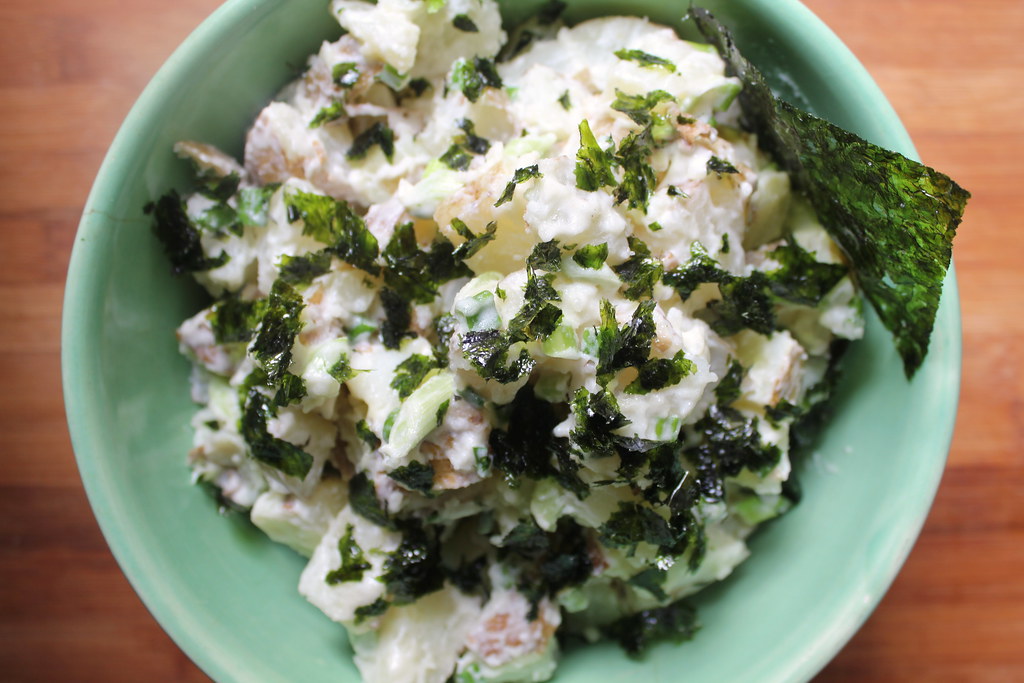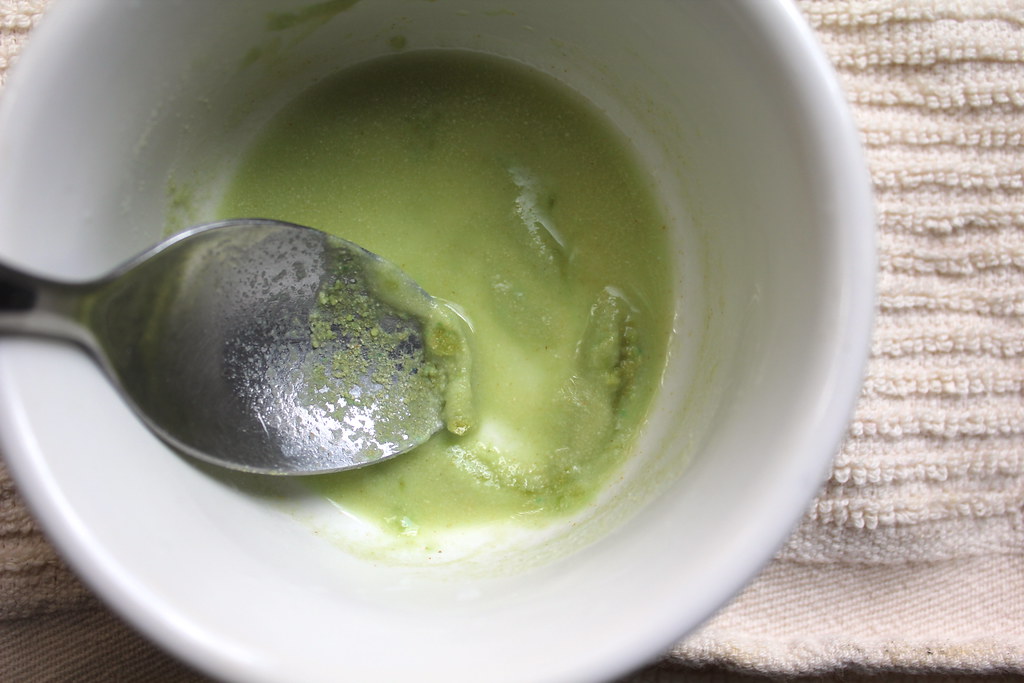
There’s German potato salad, Southern potato salad, curried potato salad, mustardy potato salad, boring potato salad, spicy potato salad, and there are lots of thick, mayonnaise-based Japanese-style potato salads, but I’ve never tried one with wasabi in it as well.
My friend Laena of international jam fame is currently obsessed with mustard, as she test-runs new recipes for production. I’ve gotten to taste a great number of mustard types lately, and my favorites were the very hot ones made with copious amounts of pure mustard powder; opening its jar might make you sneeze and eating a dab makes your eyes water. When a bunch of friends and I got together for a mustard-tasting backyard barbecue recently, many remarked that these hot mustards tasted a lot like wasabi. (They also voted in total disagreement of my mustard preferences.) So instead of adding mustard along with mayonnaise for a potato salad at another party recently, I used wasabi instead.
Let’s talk about wasabi compared to mustard for a moment. Wasabi is a root, similar to Western horseradish. Powdered wasabi doesn’t have much potency until you reconstitute it with a bit of liquid. Then it turns jade-green, forms a paste, and gets dabbed in small portions on things, often involving raw fish. Mustard powder comes from mustard seeds — black, brown, yellow or white ones — that come from the mustard plant. Its leaves are spicy, and so are its seeds. But when the seeds are ground to a fine powder then mixed with a bit of liquid, a chemical compound called allyl isothiocyanate is produced — and this is also found in wasabi.
I’m not a scientist, but I think hot mustard powder tastes on par with hot wasabi powder. So, skipping the prepared condiments, I went straight for the powdered stuff, wasabi this time. I like the control you can get from adding just as much of it as you need without the interference of other ingredients, like salt or vinegar. And I like the process of mixing up small doses of it, like a witch doctor or hack herbalist in a kitchen lab. So maybe I do liken myself a scientist. So long as it tastes good.
Now back to potato salad land (sorry, where were we?), there are a few other key flavors besides a little mustard, or, in this case, wasabi. I tried to make them all Japanese-y: rice vinegar for acidity, scallions for oniony bite, Japanese kewpie mayo for creaminess and savoriness, and nori sheets for umami. What? Seaweed in potato salad? Just a sprinkle for a crunchy garnish. I’m not sure about soggy strips of wakame seaweed for this.
I think I realize now why I favored the fiercest-tasting mustards that we tried from Laena. It’s because they were the more pure and condensed, less runny and sweet of the lot, and hence more apt for tinkering, tampering, and stretching in many culinary uses beyond the ready-to-eat. Pretty convenient if you’re a crazy person like me, I guess. Maybe not so for the general mustard-buying public.
Potato Salad with Wasabi and Nori
(makes 6-8 servings)
3 lbs potatoes, any kind (about 6 medium-sized)
1 cup mayonnaise
1 tablespoon rice vinegar (or more to taste)
½ teaspoon pure wasabi powder mixed with about 1 tablespoon water and stirred (or substitute with about 1 teaspoon prepared wasabi paste)
3 scallions, chopped
1 teaspoon Asian sesame oil
salt and ground white pepper to taste
crumbled nori (roasted seaweed sheets) for garnish
Halve the potatoes or cut to similar-sized, large pieces (if some are small enough, keep intact). Place in a pot and fill with water to cover. Add about 1 teaspoon salt, cover, and bring to a boil. Let boil for about 10 minutes, or until potatoes are just tender when poked with a fork. Drain and let cool. Once cool, cut the potatoes to cubes or wedges.
In a separate bowl, combine the mayonnaise, wasabi paste mixture, rice vinegar, sesame oil and scallions. Taste and add salt and white pepper as desired. Fold in the potatoes and stir to coat well. Taste again and add any seasonings as desired. Cover and chill preferably 30 minutes before serving, or up to 2 days. Crush the nori sheets and sprinkle on the bowl just before serving.
Cost Calculator
(for 6-8 servings)
3 lbs potatoes: $3.00
3 scallions: $0.50
1 cup mayonnaise: $1.50
1 Tb rice vinegar: $0.25
½ teaspoon wasabi powder: $0.25
1 teaspoon sesame oil, salt, white pepper: $0.25
3-4 sheets crumbled nori: $0.25
Total: $6.00
Health Factor![]()
![]()
![]()
![]()
![]()
![]()
Six maple leaves: This is not one of those good-for-you potato salads, with an olive oil-based vinaigrette and lots of green herbs. This is a heavy, creamy, classic sort of potato salad that’ll fill you up with carbs. But as a side dish, it’s meant to be part of a well-rounded picnic or barbecue spread. So pile those green salads on top of this stuff and enjoy.
Green Factor![]()
![]()
![]()
![]()
![]()
Five maple leaves: We haven’t seen new potatoes this early in the summer growing season, but potatoes keep quite long in cold storage and are sure to be found in your area any time of year. That’s mostly what this recipe has, besides a scant amount of scallions and seasonings.


6 Responses
not wasabi
Not sure if you’re aware, most “wasabi” that can be purchased in the US (even in Japan it’s only required to contain 5% wasabi to be labelled wasabi, and then they generally use the leaves to get around this requirement, wasabi being difficult and expensive to grow – not required to contain any wasabi in the US) is only a mixture of European horseradish and mustard, colored green with food coloring. That would be why it tastes similar to mustard.
Your recipe specifies “pure” wasabi powder. Is that actually what you used, or are you using the word “pure” to mean straight from the can, unmixed?
FreeRangeNan
not wasabi is right. That green powder is almost certainly horseradish, food color and (probably) mustard.
To complicate things, I’ve seen packages where the ingredient list says “wasabi” in English but the Japanese characters say “sei-yo wasabi” (“Western wasabi”) which is horseradish.
Finally, even if you ARE able to find real wasabi as a powder or in a tube, it’s a pale reflection of just-grated fresh wasabi. Not worth the price.
On the other hand, a fresh wasabi root IS worth the price (IMHO). I wouldn’t waste it on a dressing though!
Cathy Erway
@not wasabi and @FreeRangeNan Thanks for pointing this out! I have a Japanese wasabi tin but it does say that it’s blended with mustard and food coloring (although it has a picture of the wasabi root on it?). I can’t read the Japanese on the label but will try to look out for pure wasabi powder next time!
FreeRangeNan
Yes, the picture will show a wasabi root even if the product contains little or no real wasabi. Even in Japan, this cheap stuff is ubiquitous.
The Spice House carries pure wasabi powder but I doubt it would be anything near as good as fresh: http://www.thespicehouse.com/spices/pure-namida-wasabi-powder#content
If you can find fresh wasabi root, it’s worth a splurge. Grate on a very fine grater using a circular motion. To really appreciate the flavor and fragrance, try it with squares of toasted nori to accompany sake. Or if you’re in a high-end sushi place, ask if they can serve this.
Dan Dolgin
Cathy – agree with the comments about fresh wasabi vs. the “wasabi” paste products but that said, I love your potato salad idea. Just because it’s not the fresh wasabi doesn’t mean it’s not tasty in it’s own right. It’s a great spin on the dish. A possible fun addition would be taking some shelled cooked edamame and adding it in near the end. It would add some pop and texture to what already looks good.
plasterer bristol
This sounds lovely. Going to give this a go. thanks for sharing this recipe.
Simon